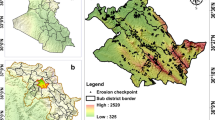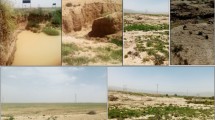Abstract
Siruvani watershed with a surface area of 205.54 km2 (20,554 hectare), forming a part of the Western Ghats in Attapady valley, Kerala, was chosen for testing RUSLE methodology in conjunction with remote sensing and GIS for soil loss prediction and identifying areas with high erosion potential. The RUSLE factors (R, K, LS, C and P) were computed from local rainfall, topographic, soil classification and remote sensing data. This study proved that the integration of soil erosion models with GIS and remote sensing is a simple and effective tool for mapping and quantifying areas and rates of soil erosion for the development of better soil conservation plans. The resultant map of annual soil erosion shows a maximum soil loss of 14.917 t h−1 year−1 and the computations suggest that about only 5.76% (1,184 hectares) of the area comes under the severe soil erosion zone followed by the high-erosion zone (11.50% of the total area). The dominant high soil erosion areas are located in the central and southern portion of the watershed and it is attributed to the shifting cultivation, and forest degradation along with the combined effect of K, LS and C factor. The RUSLE model in combination with GIS and remote sensing techniques also enables the assessment of pixel based soil erosion rate.






Similar content being viewed by others
References
Al-Quraishi AMF (2003) Soil erosion risk prediction with RS and GIS for the northwestern part of Hebei Province, China. Pak J Appl Sci 3(10–12):659–669
Angima SD, Stott DE, O’Neill MK, Ong CK, Weesies GA (2003) Soil erosion prediction using RUSLE for Central Kenyan highland conditions. Agric Ecosyst Environ 97(1–3):295–308
Arnoldus HMJ (1980) An approximation of the rainfall factor in the universal soil loss equation. In: De Boodt M, Gabriels D (eds) Assessment of erosion. Wiley, Chichester, UK, pp 127–132
Boggs G, Devonport C, Evans K, Puig P (2001) GIS-based rapid assessment of erosion risk in a small catchment in the wet/dry tropics of Australia. Land Degrad Dev 12:417–434
Chandramohan T, Durbude DG (2002) Estimation of soil erosion potential using universal soil loss equation. J Indian Soc Remote Sens 30(4):181–190
CWRDM (1997) Attapady wasteland comprehensive environmental conservation project. Eco-restoration plan, Vol 1. Center for Water Resources Development and Management, Kerala
Dabral PP, Baithuri N, Pandey A (2008) Soil erosion assessment in a hilly catchment of North Eastern India using USLE, GIS and remote sensing. Water Resour Manag 22:1783–1798
Flugel WA, Marker M, Moretti S, Rodolfi G, Sidrochuk A (2003) Integrating geographical information systems, remote sensing, ground truthing and modelling approaches for regional erosion classification of semi-arid catchments in South Africa. Hydrol Process 17:929–942
Fu g, Chen S, McCool DK (2006) Modelling the impacts of no-tillage practices on soil erosion and sediment yield with RUSLE, SEDD and ArcView GIS. Soil and Tillage Res 85 (1–2):38–49
Hoyos N (2005) Spatial modeling of soil erosion potential in a tropical watershed of the Colombian Andes. Catena 63(1):85–108
Jain SK, Kumar S, Varghese J (2001) Estimation of soil erosion for a Himalayan watershed using GIS technique. Water Resour Manag 15:41–54
Jasrotia AS, Singh R (2006) Modeling runoff and soil erosion in a catchment area, using the GIS, in the Himalayan region, India. Environ Geol 51:29–37
Karydas CG, Sekuloska T, Silleos GN (2009) Quantification and site-specification of the support practice factor when mapping soil erosion risk associated with olive plantations in the Mediterranean island of Crete. Environ Monit Assess 149:19–28
Kouli M, Soupios P, Vallianatos F (2009) Soil erosion prediction using the revised universal soil loss equation (RUSLE) in a GIS framework, Chania, Northwestern Crete, Greece. Environ Geol 57:483–497
Krishna Bahadur KC (2009) Mapping soil erosion susceptibility using remote sensing and GIS: a case of the Upper Nam Wa watershed, Nan Province, Thailand. Environ Geol 57:695–705
Kukal SS, Sur HS, Gill SS (2007) Factors responsible for soil erosion hazard in submontane Punjab, India. Soil Use Manag 7(1):38–44
Lee S (2004) Soil erosion assessment and its verification using the universal soil loss equation and geographic information system: a case study at Boun, Korea. Environ Geol 45:457–465
Lekha KR (2004) Field instrumentation and monitoring of soil erosion in coir geotextile stabilised slopes—a case study. Geotext Geomembr 22(5):399–413
Lim KJ, Myung Sagong M, Engel BA, Tang Z, Choi J, Kim K (2005) GIS-based sediment assessment tool. Catena 64:61–80
Lu D, Li G, Valladares GS, Batistella M (2004) Mapping soil erosion risk in Rondonia, Brazilian Amazonia: using RUSLE, remote sensing and GIS. Land Degrad Dev 15:499–512
Matsuura H (2000) Design guidelines for mechanical soil and water conservation works and water resources development. Technical report for the Attapady wasteland comprehensive environmental conservation project (AWCECOP), ID-P111. Attapady Hills Area Development Society, Government of Kerala
Millward AA, Mersey JE (1999) Adapting the RUSLE to model soil erosion potential in a mountainous tropical watershed. Catena 38(2):109–129
Moore ID, Burch GJ (1986a) Physical basis of the length slope factor in the universal soil loss equation. Soil Sci Soc Am 50(5):1294–1298
Moore ID, Burch GJ (1986b) Modeling erosion and deposition topographic effects. Trans Am Soc Agric Eng 29(6):1624–1630
Nair PKR, Prasannakumar V, Mathai Thomas (1981) Structure of the western termination of the Bhavani lineament. J Geol Soc India 22:285–291
Narayana VVD, Babu R (1983) Estimation of soil erosion in India. J Irrigat Drain Eng 109(4):419–434
Nasir A, Uchida K, Ashraf M (2006) Estimation of soil erosion by using RUSLE and GIS for Small Mountainous watersheds in Pakistan. Pak J Water Resour 10(1):11–21
Pandey A, Mathur A, Mishra SK, Mal BC (2009) Soil erosion modeling of a Himalayan watershed using RS and GIS. Environ Earth Sci. doi:10.1007/s12665-009-0038-0
Pimentel D, Kounang N (1998) Ecology of soil erosion in ecosystems. Ecosystems 1(5):416–426
Prasannakumar V, Lloyd GE (2007) Lattice preferred orientation and seismic properties in Bhavani shear zone, Southern India. J Geol Soc India 70:282–296
Renard KG, Foster GR, Weesies GA, McCool DK, Yoder DC (1997) Predicting soil erosion by water: a guide to conservation planning with the revised universal soil loss equation (RUSLE). Agriculture Handbook, vol 703. US Department of Agriculture, Washington, pp 1–251
Saha SK, Pande LM (1993) Integrated approach towards soil erosion inventory for environmental conservation using satellite and agrometeorological data. Asia-Pacific Remote Sens. J 5(2):21–28
Sankar S, Muraleedharan PK (1990) Human ecology in Attappady reserve. In: Nair KKN et al (eds) Tropical forest ecosystem conservation and development in South and South-east Asia. Kerala Forest Research Institute, Peechi, pp 127–131
Srinivas CV, Maji AK, Reddy GPO, Chary GR (2002) Assessment of soil erosion using remote sensing and GIS in Nagpur district, Maharashtra for prioritisation and delineation of conservation units. J Indian Soc Remote Sens 30(4):197–212
Stone RP, Hilborn D (2000) Fact sheet, universal soil loss equation. Ministry of Agriculture Food and Rural Affairs, Ontario, p 12
Tian YC, Zhou YM, Wu BF, Zhou WF (2009) Risk assessment of water soil erosion in upper basin of Miyun Reservoir, Beijing, China. Environ Geol 57:937–942
Van der Knijff JM, Jones RJA, Montanarella L (2000) Soil erosion risk assessment in Europe EUR 19044 EN. Office for Official Publications of the European Communities, Luxembourg, p 34
Wang G, Gertner G, Fang S, Anderson AB (2003) Mapping multiple variables for predicting soil loss by geostatistical methods with TM images and a slope map. Photogramm Eng Remote Sens 69:889–898
Wischmeier WH, Smith DD (1978) Predicting rainfall erosion losses—a guide to conservation planning. Agriculture Handbook, No 537. US Department of Agriculture Science and Education Administration, Washington, pp 163
Xu Y, Zhou Q, Li S (2005) An analysis on spatial–temporal distribution of rainfall erosivity in Guizhou Province. Bull Soil Water Conserv 4:11–14
Yue-qing X, Jian P, Xiao-mei S (2009) Assessment of soil erosion using RUSLE and GIS: a case study of the Maotiao river watershed, Guizhou Province, China. Environ Geol 56:1643–1652
Yuksel A, Gundogan R, Akay AE (2008) Using the remote sensing and GIS technology for erosion risk mapping of Kartalkaya Dam watershed in Kahramanmaras, Turkey. Sensors 8:4851–4865
Zhou P, Luukkanen O, Tokola T, Nieminen J (2008) Effect of vegetation cover on soil erosion in a mountainous watershed. Catena 75(3):319–325
Acknowledgments
The paper is a contribution of the Center for Geo Information Science and Technology, a joint venture of the University of Kerala, DST and KSCSTE. Financial support from DST and KSCSTE is gratefully acknowledged. The authors gratefully acknowledge the anonymous reviewers for constructive comments and suggestions.
Author information
Authors and Affiliations
Corresponding author
Rights and permissions
About this article
Cite this article
Prasannakumar, V., Shiny, R., Geetha, N. et al. Spatial prediction of soil erosion risk by remote sensing, GIS and RUSLE approach: a case study of Siruvani river watershed in Attapady valley, Kerala, India. Environ Earth Sci 64, 965–972 (2011). https://doi.org/10.1007/s12665-011-0913-3
Received:
Accepted:
Published:
Issue Date:
DOI: https://doi.org/10.1007/s12665-011-0913-3




